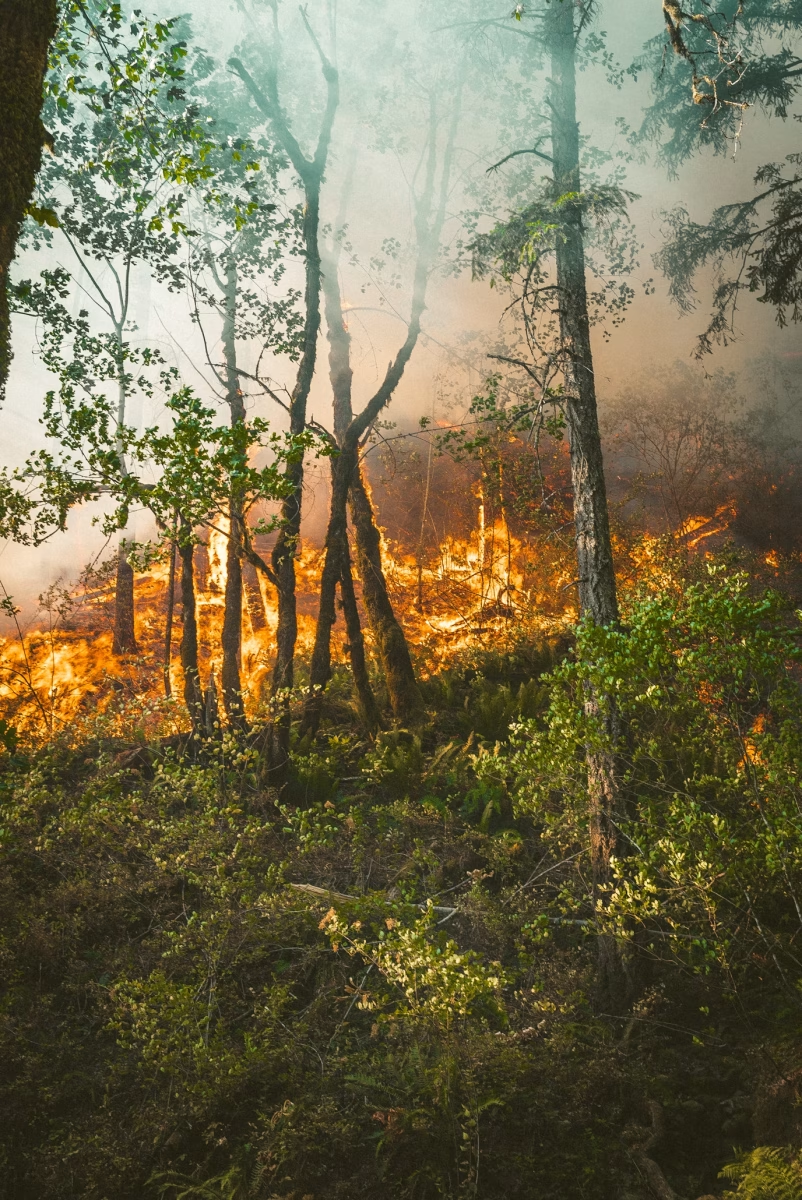Oregon is home to over 100,000 miles of rivers and streams and more than 1,400 named lakes. While Oregon has a lot of water, the state also faces a significant issue: water pollution. This issue threatens all of Oregon’s water sources and the health of its residents.
While water pollution in Oregon hasn’t changed dramatically in the past few years, it is still a struggle to keep pollution levels steady. According to the official website of the State of Oregon, 50% of sites received an excellent or good rating, 14% were rated as fair, and 36% were in poor or very poor condition.
While talking about different ways the water can get polluted, Marcos Kubow, water quality coordinator for Oregon City, said, “You are guaranteed to have work, there’s a lot of job security.”
Algal Blooms
Algae are found in all bodies of water, with a few types even producing toxins. Algal blooms form when toxic algae grow excessively and, in some cases, can even take over the entire body of water in which they are found.
“The algae blooms produce toxins that are harmful to humans and animals and can impact drinking water,” said Kubow.
According to the Oregon Veterinary Medical Association, toxic algae blooms can release a chemical called cyanobacteria, which can cause serious illness or death in pets and livestock within minutes or even hours of contact. The algae can look blueish green and can form into mats or look foamy, but it’s very hard to tell if a body of water has algae blooms by just looking at it.
“The most engaging part of my job is involving harmful algae blooms,” said Kubow. “There has been a lot of concern about algae blooms in Clackamette Cove.”
Oregon City has been monitoring the condition of Clackamette Cove, located next to Clackamette Park, by sampling the water “every 2 weeks since April 2024” for alarming amounts of algae. According to the official website of Oregon City, the samples showed that HAB (harmful algae blooms) levels were increasing, but they weren’t bad enough to form a film on the top of the water.
“The two biggest concerns right now are algae blooms and PFAS chemicals,” said Kubow
PFAS
PFAS stands for polyfluoroalkyl substances, and according to the Oregon Environmental Council, PFAS is a forever chemical. It’s a class of over “15,000 toxic chemicals.” These chemicals are used because things like water, oils, and greases don’t stick to them. They are used in a variety of products, including makeup, pizza boxes, rainproof jackets, and many other items.
“PFAS doesn’t break down well in the environment,” said Kubow.
The official website for Clackamas County helps prove this point by explaining that these chemicals take a long time to break down in the environment, and by the time they have broken down, more of these chemicals have taken their place. As of now, “more research is needed” to find out what these chemicals do to humans, but from what experiments have shown, they are not good for animals.
“By the time we can treat the biotoxins, they have usually been around for 10 – 15 years,” said Kubow
According to the National Centers for Coastal Ocean Science, there has been an outbreak of “Paralytic shellfish poisoning,” also known as PSP. Since Memorial Day weekend, there have been 31 known cases of people getting sick after eating shellfish from the Oregon coast. Oregon has closed the harvesting of these shellfish until they can obtain two consecutive tests that prove the levels of these chemicals are below the safe limit. These toxins stay in the shellfish until you eat them, with a resistance to being frozen and even cooked.
“There’s been a lot of policy changes while I’ve worked at this position to try and help prevent pollution getting worse,” said Kubow
History of Water Pollution
Water in Oregon, historically, was a very valuable resource. According to the Census of Agriculture Historical Archive, Oregon had lots of farmland with 20,327,683 acres of land being used for agriculture in the 1950s. These farms use a significant amount of water each year, in addition to the water used by cities and homes.
According to the United States Geological Survey, in 1950, the main categories using water in Oregon were Rural and self-supplied industrial, while they had fewer categories using water, they also had fewer policies regarding contamination and what could be done with the water.
Past Policies
According to the Owhyee Irrigation District, in 1909, the state of Oregon declared all surface water public property. After that, in 1955, they declared all groundwater public too, with some exceptions being city use or business. The Water Code states that the places with these exceptions must have a permit to use the water, even if that water is underground.
“We’ve had policies to maintain and improve water quality,” said Kubow.
Before the Clean Water Act was passed in 1972, the Willamette and many other Oregon water sources were red. This is because, according to the Oregon Environmental Council, people had previously been using Oregon’s water sources to dump industrial waste, toxic material, sewage, and even city and farm runoff.
“Stormwater goes straight to the streams,” said Kubow.
How to Help
While the Oregon rivers are facing some big issues now, they could get a lot better through the work of the state and people. Individual people can do a lot to help these streams and rivers, even if it’s just doing little things that might not seem too big. The state can help by implementing new policies and providing more funding to the people trying to save this resource.
“You can donate to nonprofits and other government organizations,” said Kubow.
Government
The government has helped the water quality in many ways and continues to help it with new ideas and things they try out every day.
According to the official website of Oregon City, they have been releasing a collection of “Bryozoans” into the water. These things form together to create a “Blobby” mass. These blobs feed on algae and other microbes that float around in the water, reducing the amount of algae and even clearing up the water. The clear water can increase oxygen levels to support more fish life.
Another thing that the governments have been doing to help water pollution in different areas is installing an air system in the water to circulate the lake and even provide more oxygen to the animals in the lake. One example of this is Devils Lake. According to the Devils Lake Water Improvement District, the total area of the diffuser was supposed to be about 41 acres in the deepest part of the lake.
This system ended up being a very good thing for the lake, making the levels of dissolved oxygen go up a lot in the lower areas of the lake. This system also gave the lake clearer waters along with “significantly reduced algal presence.” These changes have also brought along more native plants to the lake due to better living conditions, creating a better shoreline and healthier wildlife.
Individuals
There are lots of different ways people can help to reduce pollution in Oregon’s water sources, and lots of places they can do it from. Some of the habits people have that can pollute the water include using lots of fertilizer, pesticides, and even not picking up after their dogs, which can harm water sources.
“Specific behaviors people do can cause issues to the water,” said Kubow.
Lawn Care
Lawns are a big source of water pollution, with many things involved in caring for them. Things you might need when caring for a lawn are lawn mowers, fertilizers, pesticides, and other chemicals. When you have a lawnmower, you usually need gas and oil to maintain the machine and keep it running.
“Our biggest problem with property owners is people who think the lawn needs to be big and green,” said Kubow.
Instead of having a traditional grass lawn, you can replace it with other plants like clover. Clover lawns are a very good substitution for grass lawns due to their reduced rate of growth. These clover lawns also grow lower than grass lawns, meaning they don’t need to be mowed very often. Clover lawns are also more drought-resistant than grass lawns due to a larger root system and the small amount of water they need.
“You can use rainwater to water plants or lawns in the summer instead of taxing our drinking water,” said Kubow.
Collecting water in the winter and rainy season for watering lawns or plants in the summer is very helpful to the drinking water system. All of Oregon’s water that people can use is safe drinking water. Other than drinking, this water is used to flush toilets, take showers, and even water lawns. If more people start capturing rainwater to use on lawns and plants, it would take away a heavy amount of stress on the water system, especially in the summer when things are hot and there is a potential for a drought.
“It still baffles me that we are using clean water for things like moving our waste,” said Kubow.
Another issue with lawn care is the pesticides or fertilizers that can get into the groundwater from the lawns. These fertilizers contribute to algae blooms by giving them the nutrients that the fertilized area couldn’t take in, causing the algae to get those nutrients and grow rapidly. According to the United States Environmental Protection Agency, the two main nutrients that algae take in are phosphorus and nitrogen, two things commonly found in fertilizers.
“Try to avoid using fertilizers and pesticides on your property, and if you do use them, try to spot spray instead of using them on the whole lawn,” said Kubow.
According to the Safe Drinking Water Foundation, pesticides are also very bad for the water: “Some of the older, cheaper pesticides can remain in the soil and water for years.” This is bad because pesticides can have negative effects on human and wildlife health.
“Our motto is only rain down the drain,” said Kubow.
Car Maintenance
Cars are a big source of pollution in general, not just water pollution. According to the United States Environmental Protection Agency, oil does not dissolve in water and sticks to everything, ranging from sand to feathers. “One pint of oil can make a slick larger than a football field”. They also tell us about how Americans spill about 180 million gallons of used oil into our water supplies per year.
“Have a spill kit ready to go; it can be as simple as kitty litter,” said Kubow.
Spill kits and regular car maintenance can greatly reduce pollution. Like Kubow said, you don’t need anything too expensive for a spill kit; you only need kitty litter to clean up the spill properly. If you don’t want to use kitty litter, many other things can be used to clean up the spill; just make sure they will absorb the oil.
“Avoid using harmful soaps when washing your car; use soaps that have an EPA-approved label,” said Kubow.
The soaps you use when washing a car can have a big impact on the environment. When the soap from your car goes into the storm drain, it gets pushed out directly into nearby streams. This is problematic because most car wash soaps contain phosphates and other chemicals that can harm fish. An EPA-rated soap is safe for the environment and the people using it. It is beneficial to use these soaps because they cause less harm to the environment compared to regular soaps.
Future of Water Pollution
If everyone comes together and does a few little things each day to help improve the quality of Oregon’s rivers, they will improve greatly. The government is constantly trying to improve water quality, but it can only do so much without the help of people. According to the website Oregon’s Conservation Strategy, limited water supply is becoming a great concern for Oregon’s future in water quality. With lower water levels, the streams and rivers will become warmer, resulting in poorer water quality. Things can improve in the future, but people need to help as much as they can. If people and governments worked together to solve this issue, then the water quality issue could improve soon.







